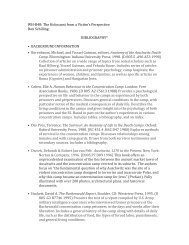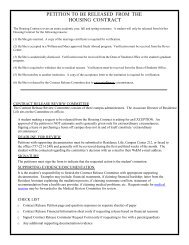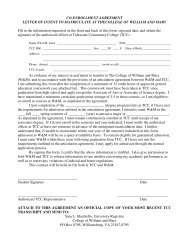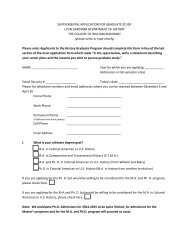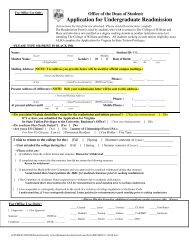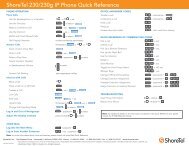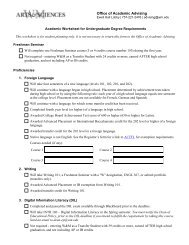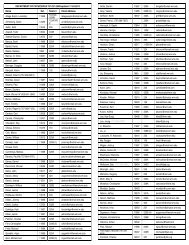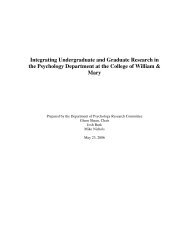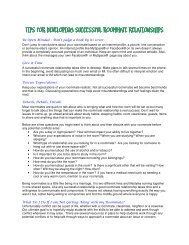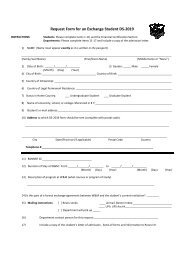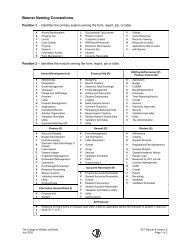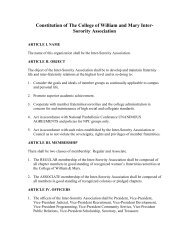Course Selection Guidebook [pdf] - College of William and Mary
Course Selection Guidebook [pdf] - College of William and Mary
Course Selection Guidebook [pdf] - College of William and Mary
You also want an ePaper? Increase the reach of your titles
YUMPU automatically turns print PDFs into web optimized ePapers that Google loves.
<strong>Course</strong> <strong>Selection</strong> <strong>Guidebook</strong> – Fall 2011addition obligation required)8. Choice <strong>of</strong> duty assignment <strong>and</strong> military specialty assignments upon commissioning9. Leadership training evaluation programs in Washington State (Fort Lewis) <strong>and</strong>Kentucky (Fort Knox).Books <strong>and</strong> Uniforms:The Department <strong>of</strong> Military Science provides required uniforms <strong>and</strong> equipment that are wornduring military activities. The department also provides course materials <strong>and</strong> texts to students free<strong>of</strong> charge for MLSC 101, 102, 201, <strong>and</strong> 202.Requirements for EnrollmentAny full-time freshman or sophomore student not already holding a commission in any <strong>of</strong> theArmed Forces may enroll in the Basic <strong>Course</strong>s. Students who have had prior military service orwho have completed courses in another ROTC program may be granted placement credit. Studentsmay attend Basic Camp or Leadership Training <strong>Course</strong> (LTC) in lieu <strong>of</strong> taking the Basic <strong>Course</strong>s.Introductory <strong>Course</strong>s(Note: Eight <strong>of</strong> the eight Military Science credits count toward the 120 credits needed forgraduation. The remaining four credits will appear on the student’s <strong>of</strong>ficial transcripts.)The Military Science Curriculum includes Basic <strong>Course</strong>s <strong>and</strong> Advanced <strong>Course</strong>s. The Basic<strong>Course</strong>s introduce students to the fundamentals <strong>of</strong> leadership <strong>and</strong> management while they learnabout the opportunities <strong>and</strong> prospects <strong>of</strong> ROTC <strong>and</strong> commissioned service. After completing theBasic <strong>Course</strong>, students who have agreed to seek commission as <strong>of</strong>ficers in the United States Armymay enroll in the Advanced <strong>Course</strong>s.Students incur no obligation to the military by participating in freshman or sophomore MilitaryScience <strong>and</strong> Leadership courses while qualifying for the Advanced Program (except for Armyscholarship students). The Military Science Basic <strong>Course</strong>s designed for freshmen <strong>and</strong> sophomoresare MLSC 101, 102, 201, <strong>and</strong> 202. All cadets participate in the Leadership Laboratory in the basiccourses; freshmen <strong>and</strong> sophomores enroll in MLSC 103 <strong>and</strong> MLSC 203, respectively.MLSC 101. Foundations <strong>of</strong> Officership. Fall (1) Corequisite: MLSC 103 (Leadership Lab)The course curriculum introduces <strong>William</strong> & <strong>Mary</strong> students to the Army’s value system, militarystructure, leadership <strong>and</strong> core competencies that are critical central to a commissioned <strong>of</strong>ficer’ssuccess in the <strong>of</strong>ficer pr<strong>of</strong>ession. Establish framework for underst<strong>and</strong>ing <strong>of</strong>ficership, leadership,<strong>and</strong> Army values followed <strong>and</strong> “life skills” such as physical fitness <strong>and</strong> time management.MLSC 102. Basic Leadership.. Spring (1) Corequisite: MLSC 103 (Leadership Lab)The course curriculum Establishes the foundation <strong>of</strong> basic leadership fundamentals such asproblem solving, communications, briefings <strong>and</strong> effective writing, goal setting, techniques forimproving listening <strong>and</strong> speaking skills, <strong>and</strong> an introduction to counseling.MLSC 201. Individual Leadership Studies. Fall (1) Prerequisite: MLSC 101/102 or equivalent.Corequisite: MLSC 203. Students identify successful leadership characteristics throughobservation <strong>of</strong> others <strong>and</strong> self through experiential learning exercises. Students record observedtraits (good <strong>and</strong> bad) in a dimensional leadership journal <strong>and</strong> discuss observations in small groupsettings.61


![Course Selection Guidebook [pdf] - College of William and Mary](https://img.yumpu.com/46952524/61/500x640/course-selection-guidebook-pdf-college-of-william-and-mary.jpg)
